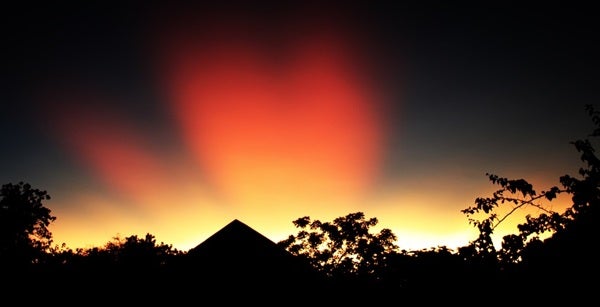The powerful Jan. 15, 2022, eruption of the Hunga Tonga-Hunga Ha‘apai volcano in the South Pacific archipelago nation of Tonga produced plumes that reached an altitude of 36 miles (58 kilometers). The plume contained 400,000 tons of sulfur dioxide, which drifted west with the stratospheric winds — and soon began to produce remarkable sunsets in the Southern Hemisphere. Stunning images appeared in the news as the cloud swept west over Australia.
Five days later, the cloud passed over southern Africa, including my home in Maun, Botswana. It arrived as a high-altitude haze blanketing the Sun, which shone as if seen through frosted glass. Closer inspection of the haze revealed it was composed of irregularly spaced ripple clouds, giving the sky a crinoline texture.
Contrast between the clouds and sky intensified around the time of sunset, when they underwent magnificent color changes, morphing from silvery blue to tangerine infused with lemon to a velvety scarlet reminiscent of Edvard Munch’s The Scream. As the Sun set, the clouds in the west appeared so optically thick that I couldn’t imagine starlight penetrating them. But come twilight, the stars and planets burned through them seemingly unimpeded.
Over the next three days, the rippled sky put on phenomenal shows of light, color, texture, and tone. Even after the official start of night, volcanic glow and ruffled clouds remained visible to the unaided eye close to the western horizon for several minutes.
Bishop’s Ring
The rarest of the phenomena was the occurrence of Bishop’s Ring — an enormous single-ringed aureole of light centered on the Sun or Moon. Typically, a solar or lunar aureole — formed by the diffraction of light by water droplets in clouds — has a radius ranging from 0.4° to several degrees, depending on droplet size. The radius of Bishop’s Ring, however, usually consists of a roughly 20° silvery blue interior surrounded by a diffuse, smoky orange outer ring (adding an additional 10° to 20° or more to the Ring’s radius, depending on particle size).
Sereno Edwards Bishop of Honolulu first recorded the phenomenon in the aftermath of the 1883 eruption of Indonesia’s Krakatau volcano. More than a century later, following the 1991 eruption of Mount Pinatubo in the Philippines, lidar studies of Bishop’s Ring found that this diffraction phenomenon was caused by frozen sulfuric acid particles with a radius of about 0.8 microns.
The Tongan volcanic clouds vanished after Jan. 25, — only to return 10 days later, creating further stunning displays (although the rippling effect was diminished). February’s waxing Moon also allowed me to measure Bishop’s Ring visually and photographically. Interestingly, the radius of the ring near First Quarter Moon was only about half the radius near Full Moon, a 10° inner aureole versus a 20° inner aureole. In both cases, the outer aureole essentially matched the size of the inner aureole.
It is unclear how long the atmospheric effects will linger or how widespread across the globe they will be. As always, send any observations you have made of these phenomena to sjomeara31@gmail.com.










